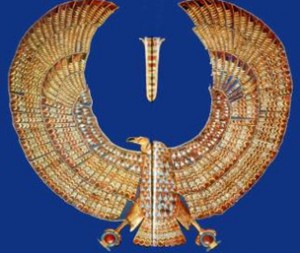The Egyptians used glass extensively in their jewellery. It was used to create a plethora of different coloured beads which were then strung together, sometimes with gold, to make fabulous collars, necklaces, rings and earrings.
Glass was also used in intricate cloisonné work which is evident in many of the more important pieces of Egyptian jewellery of the time. The introducing of Egyptian glass jewellery meant jewellery craftsmen could imitate real stones, making it arguably the first costume jewellery!
Beads were perhaps one of the most popular and versatile components of Egyptian jewellery. They were made in every material and instead of using expensive sheet. These Egyptian beads could be built up in considerable numbers to create large areas of decoration which are so synonymous with Egyptian jewellery design.
What did the Egyptian colour scheme mean In Egyptian Jewellery?
It’s worth noting the importance of the Egyptian colour scheme, especially in Egyptian jewellery. They may not have had the range and options that we have today, but each colour used held great symbolic significance much like the jewellery that contained it.
Blue was said to symbolize ‘rebirth and the shimmering sun’, and red with ‘birth and destruction”, associated with Osiris, the God of the Dead. However, it was gold/yellow which was revered above all others due to its association with the sun and ‘the flesh of the Gods’. It was the colour of the gods and royalty, and was the object of desire for most people, which is not so dissimilar to the way our jewellery culture is known today.
Egyptian Jewellery Fact File:
Egyptian Jewellery Materials used:
Gold, Electrum, Coloured Glass, Semi-Precious stones (Lapis Lazuli, Carnelian, Jasper, Stone, Turquoise, feldspar, steatite).
Popular Ancient Egyptian Jewellery:
Collars, Bangles, Bracelets, Earrings, Beads, rings with swivelling bezels, amulets.
Egyptian Motifs:
Scarabs, palm leaves, poppy petals, bunches of grapes, lotus flowers, daisies, jasmine blossom, gods and goddesses.
Egyptian Jewellery Timeline:
Old Kingdom – (3200-2180BC)
- Upper and lower Egypt were united to form the first dynasty.
- Egypt saw great advances in agriculture, metalwork, communication and transportation.
- Memphis was the capital.
- Ra is the chief god.
- Pharaohs were all powerful rulers.
- The age of the pyramids began.
Middle Kingdom – (2040-1674 BC)
- Thebes was established as the capital by Mentuhotep of the Eleventh Dynasty.
- The powers of the Pharaohs somewhat diminished.
- Trade with other lands increased.
- Irrigation methods improved.
- Copper and Turquoise were mined.
New Kingdom – (1570-1070 BC)
- Ahmose I began the Eighteenth Dynasty.
- Art and Architecture developed greatly
- The first monotheistic religion is established as Amenhotep IV insists Aton; The sun god is the sole subject of worship. (Which was extremely unpopular with the people)
- A new capital was built – Akhetaton
- Later, his son-in-law Tutankhamun returns the capital to Thebes.
Perhaps learning about ancient Egyptian jewellery has you curious about other jewellery histories? Learn more about the history of jewellery making today.
